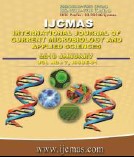


 National Academy of Agricultural Sciences (NAAS)
National Academy of Agricultural Sciences (NAAS)

|
PRINT ISSN : 2319-7692
Online ISSN : 2319-7706 Issues : 12 per year Publisher : Excellent Publishers Email : editorijcmas@gmail.com / submit@ijcmas.com Editor-in-chief: Dr.M.Prakash Index Copernicus ICV 2018: 95.39 NAAS RATING 2020: 5.38 |
Phenol and its components are extremely toxic and can easily be isolated from different industrial sewage such as oil refinery, petrochemical industry and mines, especially chemical factories causing pollution in water bodies. Rivers and oceans are contaminated on a large scale with these toxic compounds. In the past, physicochemical method was used for the elimination of phenol and its compounds, but today, bioremediation is preferable. The aim of this study is to isolate promising halophilic bacteria from Lonar Lake showing phenol degradation in wide pH range (neutral as well as alkaline). Different isolates from Lonar Lake were tested for growth in presence of phenol as sole C source. The isolate growing in high phenol concentration was identified on basis of biochemical identification methods and 16s sequencing. Finally, the ability of bacteria to degrade different concentration of phenol was measured using culturing bacteria in different concentration of phenol from 0.3 to 1.0 g/l. and turbidity was measured after 24-48 days. The phenol degradation was estimated using Folin Lowry method after 48 hrs of inoculation. The isolated bacteria was identified as Halomonas campisalis.
 |
 |
 |
 |
 |